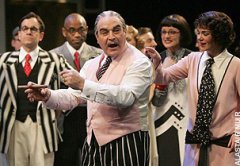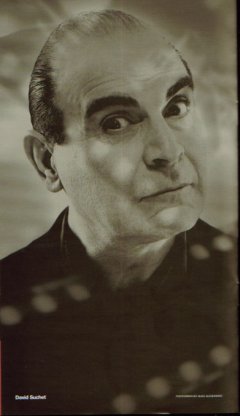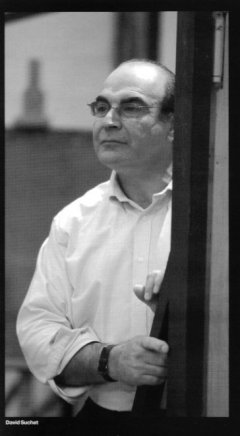 Once in a Lifetime
Once in a Lifetime
by Moss Hart and George S. Kaufman (1930)
Opened at the National Theatre (Olivier), Dec 2005
Run time: 2hrs 20-45 mins
Director: Edward Hall
Design: Mark Thompson
Lighting: Hugh Vanstone
Sound: Paul Groothuis
Musical arrangement and direction: Martin Lowe
Musical staging: Rob Ashford
Synopsis Notes
Run Sheet
Opening:
National Theatre......... 5 Dec 2005 - 11 Mar 2006
Cast according to the programme
Adrian Scarborough..... George Lewis
Victoria Hamilton..... May Daniels
Lloyd Hutchinson..... Jerry Hyland
Issy van Randwyck..... Helen Hobart (Hollywood gossip columnist)
Caroline Sheen..... Susan Walker
Marcia Warren..... Mrs. Walker
David Suchet..... Herman Glogauer (producer, head of Glogauer Studios)
Jonathan McGuinness..... Lawrence Vail (New York playwright)
Tim McMullen..... Rudolph Kammerling (German director)
Additional cast:
Sarah Annis, Paul Basleigh, Kate Best, Paul Cawley, Alan Cooke, Edwina Cox, Joshua Dallas, Lisa Donmall, Serena Evans, Nick Fletcher, Akiya Henry, Alexis Owen Hobbs, William Osbourne, Michael Rouse, Adam Shipway, Rachel Stanley, Jack Tarlton, Nicholas Tizzard, Emma Tunmore, Inika Leigh Wright, Matt Zimmerman
The Band:
Kay Bywater, Tracy Holloway, Michael Lowatt, Martin Lowe, Ed Morris, Andy Taylor, Matt Whittington
Synopsis
When Warner Brothers’ first talking picture The Jazz Singer with Al Jolson was released in 1927, it ushered in a new era in film making and created a 'crowd' of wannabes flocking to Hollywood with the hope of making stardom and fortunes.
Three low-grade New Yorker vaudeville actors, May, Jerry and innocent, dim-witted and constantly nut eating George, decide to join the gold rush to Tinseltown. They dream of making big money by setting themselves up as voice coaches for squawking silent film stars, who are in the need of learning how to 'speak properly’ in the ‘talkies’.
 On the train to LA they bump in to one of May's former troupe colleagues, Helen Hobart, who has now become a prominent film critic and gossip columnist. She mistakes the three (with a little help from May) to be successfull experts in Voice Culture and sets up a meeting with Herman Glogauer, a Hollywood movie mogul and head of Glogauer Studios.
On the train to LA they bump in to one of May's former troupe colleagues, Helen Hobart, who has now become a prominent film critic and gossip columnist. She mistakes the three (with a little help from May) to be successfull experts in Voice Culture and sets up a meeting with Herman Glogauer, a Hollywood movie mogul and head of Glogauer Studios. Having previously turned down the Vitaphone film sound system and now being in competition with a rival studio owned by the 12 Schlepkin Brothers, Glogauer immediately hires the three to coach his silent film stars. After six weeks and some test results he's not impressed and fires them - except for George... Dim-witted, nut cracking George has a habit of repeating opinions he has heard or read in Variety, and Glogauer mistakes him for a visionary genius and puts him in charge of the Studio’s production. George seems to be a disaster for the job; he picks up the wrong script and starts to shoot it, lights only half of it and spoils the sound track with his compulsive nut cracking... but despite his incompetence in movie making, the film ironically becomes a smashing hit...
Notes
Apparently there are a lot of second-timers in here...
The play has only been produced for the UK stage twice; first time was in 1979 at the Aldwych in Trevor Nunn’s award-winning RSC production, in which Suchet also played movie mogul Glogauer. So, as Suchet jokes about it himself, it's Twice in a Lifetime, he gets to play the part... It’s also the second time, Suchet gets to sing in a production; first time was as Sid Field in What a Performance. Hopefully the singing won't restrict itself to only twice in Suchet's lifetime...
Last time Suchet worked with a Hall director was in the play Amadeus, directed by Peter Hall, father of Edward Hall, in the 1998-2000 production at the Old Vic and on Broadway. By the way, Peter Hall carries the title of Sir nowadays...
Once in a Lifetime was the first play George S. Kaufman and Moss Hart did together out of several, among them You can't take it with you and The Man who came to Dinner. When they started their co-work, Kaufmann was already an established comedy writer on Broadway, while Hart was a first-time writer. Hart approached Kaufman with a draft on Once in a Lifetime in 1929, and they finished and produced it together. It opened at the Music Box Theatre on Broadway in 1930 and was a huge success, running 305 performances. Besides being co-writer on the play Kaufman also directed it and played the part of Lawrence Vail, a role Hart took over in a later Los Angeles production.
The play was adapted for a film version in 1932, directed by Russel Mack. It was also adapted for television in 1988 in a BBC production (an episode of Great Performances), in which both Zoë Wanamaker as May and David Suchet as Herman Glogauer reprised their RSC stage roles from the 1979 production. The supporting cast was different to that of the stage run, and it was directed by Robin Midgley. Check with Inbaseline for the rest of the cast and crew.
It’s possible to download and purchase a study of the play online on BookRags or on enotes
top
The Press wrote:
Daily Telegraph: ‘Adrian Scarborough is irresistibly comic ... Victoria Hamilton is superb ... David Suchet gives a high-definition performance as the megalomaniac studio boss Herman Glogauer ... Issy van Randwyck' offers a lethally accurate evocation of journalistic vanity as the powerful Hollywood reporter ... What a pleasure it is to discover that Broadway's revenge on Hollywood still cuts the mustard three quarters of a century after its premiere.'
 Daily Telegraph: 'There are moments of pure pleasure in Edward Hall's sleek and affectionate revival, with glamorous twenties designs by Mark Thompson and scenes where the wise-cracking satire threatens to turn into a full-blown musical as the cast belt out period songs. This wry, theatrical examination of the follies of the film industry still seems bang on the money, the plot purrs along like a well-oiled laughter machine, and the dialogue brims with the sharp, drop-dead wisecracks that have always been such a feature of American comedy.'
Daily Telegraph: 'There are moments of pure pleasure in Edward Hall's sleek and affectionate revival, with glamorous twenties designs by Mark Thompson and scenes where the wise-cracking satire threatens to turn into a full-blown musical as the cast belt out period songs. This wry, theatrical examination of the follies of the film industry still seems bang on the money, the plot purrs along like a well-oiled laughter machine, and the dialogue brims with the sharp, drop-dead wisecracks that have always been such a feature of American comedy.'
Independent on Sunday: 'Mark Thompson's opulent and witty designs. The National Theatre's production is staged by Edward Hall with admirable panache ... David Suchet has wonderful comic timing...It would also be hard to improve on Adrian Scarborough's loveable George ... Painfully funny.'
Observer: 'David Suchet plays the boss with massive enjoyable swagger; Marcia Warren dodders with an impeccable straight face, and Adrian Scarborough proves comically nimble.'
Reviews:
Production photos
Rehearsing...
Peeking during rehearsal...
Luca Balduzzi has sent me some great stuff in connection to Once in a Lifetime. Luca is a freelance journalist and the main researcher/writer on the splendid and comprehensive Suchet entry on the Italian Wikipedia. He also made an interesting interview with Suchet during the run of Once in a Lifetime, and I’m thrilled to bring it here via an mp3 file - it has never been broadcast before, but the edited ‘paper’ version is on the Net. Suchet gets on to some very interesting subjects in there, like the differences between this and the 1979 production, how he approached the plays and characters of Shakespeare when joining the RSC, Poirot, the film Flood and computer expences, the differences between acting on film and on stage... and about believing the time has come to try out directing a play or a film...
Thanks for sharing this splendid material, Luca!
Vitaphone and The Jazz Singer:
Vitaphone was a soundtrack system with film music and sound effects recorded on gramophone discs - when a silent film was running, the disc would then be played synchronously. It was developed in 1925 by Western Electric and bought by Warner Brothers. Up till the invention of sound-on-discs, silent films had mostly been accompanied by a pianist and in some occasions a minor orchestra. In order to use Vitaphone theatres would have to get sound installations (wired speakers, amplifiers etc.), an investment not all theatre-owners were interested in - and most Hollywood producers didn’t think the system would survive, anyway, and called it ‘a flash in the pan’.
Then Warner Brothers decided to promote Vitaphone by showing its full potential using Al Jolson to do the job in a film called The Jazz Singer. Jolson was an extremely successful performer, magnetic on stage but had never made it on silent film, because his style depended on his voice. When he appeared on screen with a synchronous soundtrack of 20 minutes of song and talk, it caused a sensation and made film history.
What Kaufman’s site has to say about The Jazz Singer:
“Released on October 10, 1927 by Warner Brothers, this is the film that
revolutionized Hollywood. Based on a story by Samson Raphaelson, it's about a Jewish performer who turns his back on his faith to become a vaudeville sensation (and his faith calls him back). It was not the first all-talking picture; rather, it has about 20 minutes of talking and songs--however, those moments were the most powerful in a feature-length film ever. "You ain't heard nothin' yet!" was Jolson's first line and it became a battlecry for sound film. It was an immense success, the Number #2 film of 1927, despite being in general
release for only several weeks”.
b/w programme photos provided by Diana. Thanks, Diana!
January 2008 © All rights reserved
Last updated February 2008
 Once in a Lifetime
Once in a Lifetime On the train to LA they bump in to one of May's former troupe colleagues, Helen Hobart, who has now become a
On the train to LA they bump in to one of May's former troupe colleagues, Helen Hobart, who has now become a  Daily Telegraph: 'There are moments of pure pleasure in Edward Hall's sleek and affectionate revival, with glamorous twenties designs by Mark Thompson and scenes where the wise-cracking satire threatens to turn into a full-blown musical as the cast belt out period songs. This wry, theatrical examination of the follies of the film industry still seems bang on the money, the plot purrs along like a well-oiled laughter machine, and the dialogue brims with the sharp, drop-dead wisecracks that have always been such a feature of American comedy.'
Daily Telegraph: 'There are moments of pure pleasure in Edward Hall's sleek and affectionate revival, with glamorous twenties designs by Mark Thompson and scenes where the wise-cracking satire threatens to turn into a full-blown musical as the cast belt out period songs. This wry, theatrical examination of the follies of the film industry still seems bang on the money, the plot purrs along like a well-oiled laughter machine, and the dialogue brims with the sharp, drop-dead wisecracks that have always been such a feature of American comedy.' 
